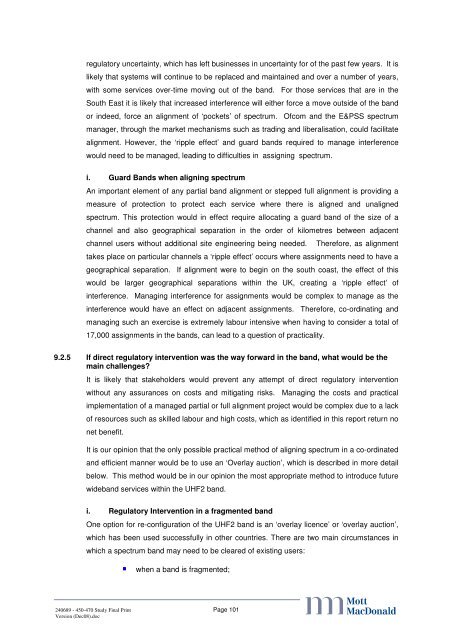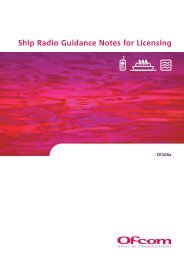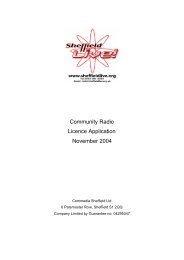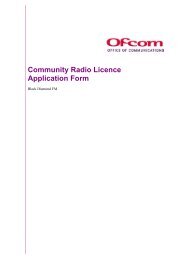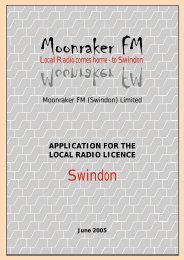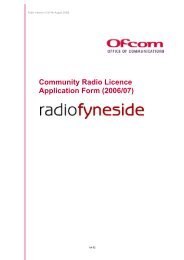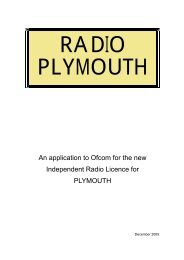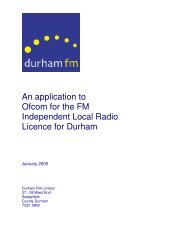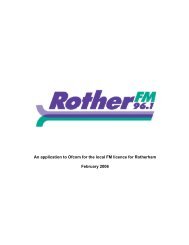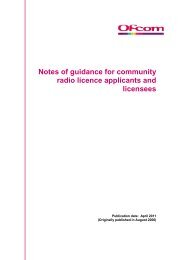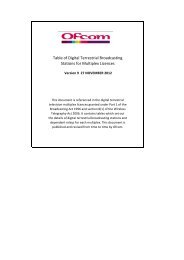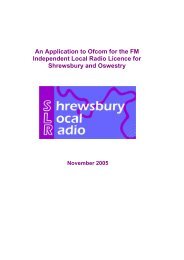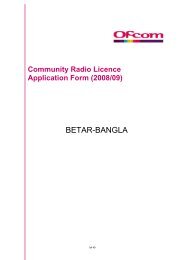UHF2 realignment study - Ofcom Licensing
UHF2 realignment study - Ofcom Licensing
UHF2 realignment study - Ofcom Licensing
Create successful ePaper yourself
Turn your PDF publications into a flip-book with our unique Google optimized e-Paper software.
egulatory uncertainty, which has left businesses in uncertainty for of the past few years. It is<br />
likely that systems will continue to be replaced and maintained and over a number of years,<br />
with some services over-time moving out of the band. For those services that are in the<br />
South East it is likely that increased interference will either force a move outside of the band<br />
or indeed, force an alignment of ‘pockets’ of spectrum. <strong>Ofcom</strong> and the E&PSS spectrum<br />
manager, through the market mechanisms such as trading and liberalisation, could facilitate<br />
alignment. However, the ‘ripple effect’ and guard bands required to manage interference<br />
would need to be managed, leading to difficulties in assigning spectrum.<br />
i. Guard Bands when aligning spectrum<br />
An important element of any partial band alignment or stepped full alignment is providing a<br />
measure of protection to protect each service where there is aligned and unaligned<br />
spectrum. This protection would in effect require allocating a guard band of the size of a<br />
channel and also geographical separation in the order of kilometres between adjacent<br />
channel users without additional site engineering being needed. Therefore, as alignment<br />
takes place on particular channels a ‘ripple effect’ occurs where assignments need to have a<br />
geographical separation. If alignment were to begin on the south coast, the effect of this<br />
would be larger geographical separations within the UK, creating a ‘ripple effect’ of<br />
interference. Managing interference for assignments would be complex to manage as the<br />
interference would have an effect on adjacent assignments. Therefore, co-ordinating and<br />
managing such an exercise is extremely labour intensive when having to consider a total of<br />
17,000 assignments in the bands, can lead to a question of practicality.<br />
9.2.5 If direct regulatory intervention was the way forward in the band, what would be the<br />
main challenges?<br />
It is likely that stakeholders would prevent any attempt of direct regulatory intervention<br />
without any assurances on costs and mitigating risks. Managing the costs and practical<br />
implementation of a managed partial or full alignment project would be complex due to a lack<br />
of resources such as skilled labour and high costs, which as identified in this report return no<br />
net benefit.<br />
It is our opinion that the only possible practical method of aligning spectrum in a co-ordinated<br />
and efficient manner would be to use an ‘Overlay auction’, which is described in more detail<br />
below. This method would be in our opinion the most appropriate method to introduce future<br />
wideband services within the <strong>UHF2</strong> band.<br />
i. Regulatory Intervention in a fragmented band<br />
One option for re-configuration of the <strong>UHF2</strong> band is an ‘overlay licence’ or ‘overlay auction’,<br />
which has been used successfully in other countries. There are two main circumstances in<br />
which a spectrum band may need to be cleared of existing users:<br />
240689 - 450-470 Study Final Print<br />
Version (Dec08).doc<br />
when a band is fragmented;<br />
Page 101<br />
abc


